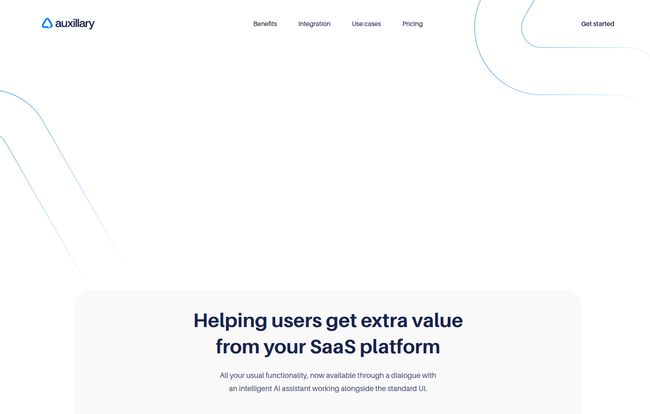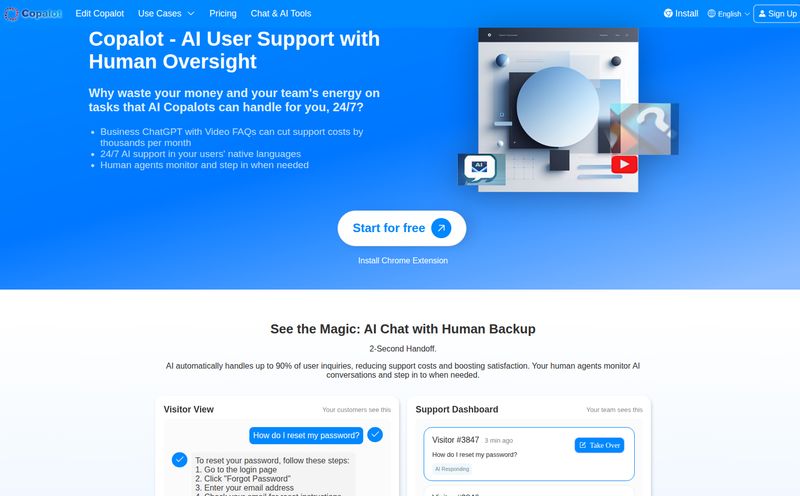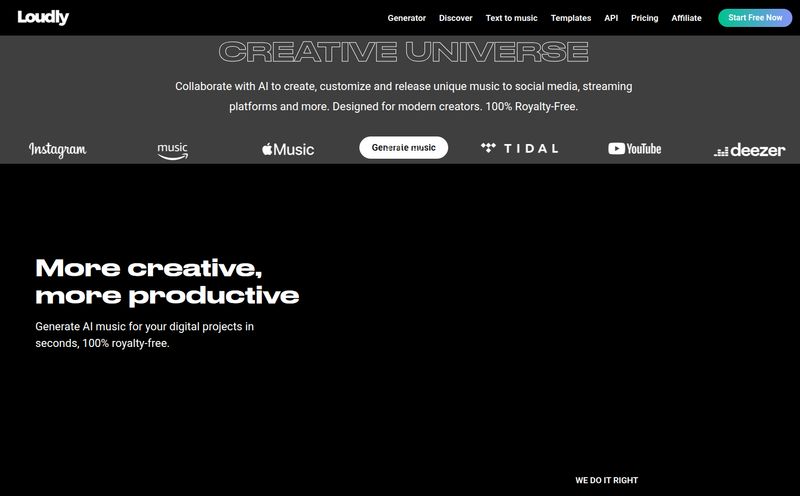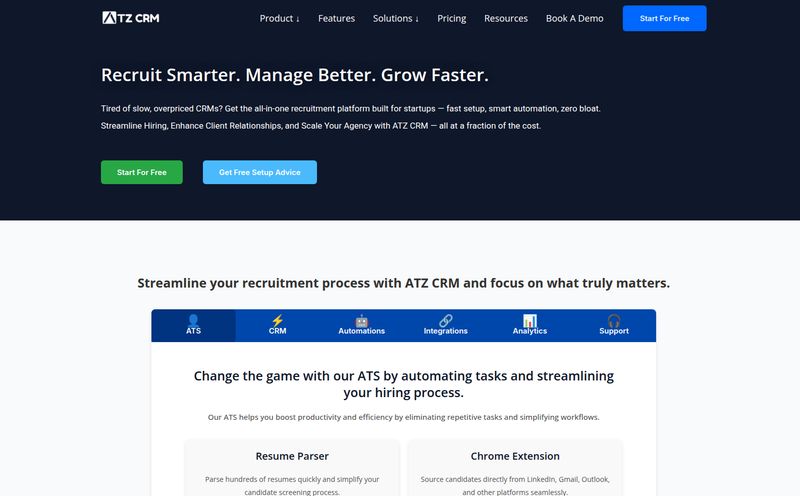We’ve all been there. Your company drops a small fortune on a shiny new B2B SaaS platform. It promises to solve all your problems, organize your life, and probably even walk your dog. For the first week, it’s exciting. Then, you realize it has more buttons, menus, and sub-menus than a 747 cockpit. A month later, 90% of your team is only using two features, and the rest of the platform becomes a digital ghost town. A “feature graveyard.”
It’s a tale as old as software itself. The more powerful a tool becomes, the steeper the learning curve. We’re drowning in functionality we don't know how to use. For years, the answer has been more tutorials, more documentation, more webinars… more work for the user. But what if the platform could just… understand you?
That's the promise of a new wave of tools called AI copilots. And today, I'm taking a look at a really interesting player in this space: Auxillary AI.
So, What Exactly Is Auxillary AI?
Let's get this out of the way: this isn’t just another chatbot in the corner of your screen. I’ve seen enough of those to last a lifetime. Auxillary AI pitches itself as an AI copilot that integrates directly into B2B platforms. The idea is that instead of clicking through a maze of menus, your users can just talk to your product in plain English (or other languages, for that matter).
Think of it less like a FAQ bot and more like having a senior-level expert sitting next to your user, ready to help. You can ask it to find information, but you can also tell it to do things. That's the key difference. It bridges the gap between knowing what you want to do and knowing how to do it within the software's interface. It’s designed to make your powerful, complex platform feel as easy to use as sending a text message.
Why We’re Drowning in SaaS Features and Why Copilots Are the Life Raft
The SaaS market is, frankly, bloated. In the race to out-do competitors, companies cram more and more features into their products. It looks great on a sales deck but often leads to a terrible user experience. User adoption rates suffer, churn increases, and all that brilliant engineering work goes to waste. It's a massive, expensive problem.
This is where a tool like Auxillary AI comes in. It doesn’t replace your UI; it augments it. It provides a conversational layer that sits on top of all that complexity. For new users, this is a game-changer. The dreaded “empty state” problem, where a user logs in for the first time and has no idea what to do, can be solved by a simple prompt: “Welcome! What would you like to accomplish today?” Suddenly, onboarding isn't a chore, it’s a conversation.
Breaking Down The Core Features
Okay, let’s get into the nitty-gritty. What can this thing actually do? The functionality is pretty impressive when you break it down.
It's Not Just a Chatbot, It's a Doer
This is the part that got my attention. Auxillary AI combines Data Retrieval with Action Execution. So, a user can ask, “Can you show me all the leads that came from the Q2 campaign?” and the AI will pull that data. But the next step is what matters. The user can then say, “Okay, great. Now create a report from that data and email it to the sales team.” That’s a multi-step workflow that might have taken 15 clicks and three different screens, now done in two sentences. They call this 'Seamless Flows,' and it's a powerful concept.
The Proactive Nudge We All Need
Another clever feature is its Proactive Guidance. The AI can be programmed to educate users as they go. Imagine a user who has only ever used one part of your marketing automation tool. The AI could pop up and say, “I see you’ve been creating a lot of email campaigns. Did you know you can also use this data to build a lookalike audience on Facebook with just one command?” This is huge for feature discovery and for helping customers get the full value out of their subscription.

Visit Auxillary AI
Finally, See What Your Users Actually Want
For any product manager or marketer, this is gold. Auxillary provides Insights and Observability. You get a dashboard that shows you what your users are asking for, where they're getting stuck, and what actions they're trying to perform. This is a direct pipeline into the user’s brain. You’re not guessing what features to build next; your users are literally telling you what they want. It’s raw, unfiltered user feedback.
Let's Talk Use Cases: Where Does This Actually Fit?
This all sounds great in theory, but where does it work in practice? The site mentions a few key areas, and my mind started racing with possibilities.
- PropTech Platforms: Imagine a real estate analytics platform. Instead of fiddling with dozens of filters, an agent could just type: “Find me all 3-bedroom properties in the 90210 zip code that have had a price reduction in the last 30 days and have a pool.” Boom. Done.
- Marketing Platforms: I touched on this before, but think about a complex CRM or marketing automation tool. “Create an audience segment of all users who have purchased more than twice in the last six months but haven’t opened an email in 60 days.” Then, “Add that segment to the ‘Q3 Re-engagement’ campaign.” It turns complex logic into simple commands.
- BI Platforms: Business intelligence tools are notoriously powerful but intimidating. An executive who doesn’t have time to learn a new interface could just ask, “What was our month-over-month revenue growth for the European market in Q1?” and get an instant answer, chart and all.
The All-Important Question: Pricing
Alright, money talk. Everyones favorite subject. I was actually pleasantly surprised by the accessibility here. Auxillary AI seems to understand that companies need to test the waters before committing big bucks. Here’s a quick breakdown of their pricing model:
| Plan | Starting Price | Details |
|---|---|---|
| Growth | $20 / month | Covers from 100 up to 50,000 messages per month. Plus, they offer a $10 free credit to get started. |
| Enterprise | $800 / month | For usage over 4,000 messages a month and requires talking to their sales team. |
My take? The Growth plan is a fantastic entry point. Starting at just $20 is a no-brainer for any SaaS company that wants to experiment with an AI copilot without a massive upfront investment. The message-based pricing is fair and scales with your usage. The jump to the Enterprise plan at $800 is significant, which clearly positions it for larger companies with established user bases and heavy interaction volume. The free $10 credit is a nice touch, removing any friction to just giving it a try.
The Not-So-Perfect Bits (Let's Be Real)
No tool is perfect, and it’s important to be realistic. The effectiveness of Auxillary AI hinges entirely on a couple of things. First, the quality of your platform's data and APIs. As the old saying goes, garbage in, garbage out. If your backend is a mess, the AI is going to struggle. It needs clean, well-documented APIs to connect to in order to perform actions and retrieve data accurately.
Second, while it’s powerful, there will be edge cases—complex or ambiguously worded queries it just can't handle. That's why having a solid human support fallback is critical. You can't just set it and forget it completely. It's a copilot, not the entire flight crew.
My Final Take: Is Auxillary AI Worth It?
Honestly, I'm pretty bullish on this. For years, we've been trying to teach humans to think like computers. The entire field of UX design is about making computer logic more palatable to the human brain. Tools like Auxillary AI flip that script. They teach the computer to understand the human.
So, who is this for? I think any B2B SaaS company that describes its product as “powerful” or “robust” should be looking at this. If you have a problem with user onboarding, feature adoption, or a high support ticket volume from users who can't find things, this could be a revelation. It's for companies who want to unlock the value thats already sitting inside their product, just waiting to be discovered.
It might not be for very simple, single-purpose apps. But for the sprawling, feature-rich platforms that dominate the B2B world, this feels less like a nice-to-have and more like the future of software interaction.
Frequently Asked Questions
What is Auxillary AI and how does it work?
Auxillary AI is an AI copilot that integrates into B2B SaaS platforms. It works by connecting to your platform's APIs, allowing it to understand natural language commands. Users can ask it to find data or perform actions, and the AI translates these requests into API calls to get the job done, all within a conversational interface.
How does Auxillary AI improve the user experience?
It drastically reduces the cognitive load on users. Instead of needing to learn and remember a complex user interface, they can simply state their intent. This reduces clicks, saves time, and makes powerful features more accessible, leading to higher user satisfaction and engagement.
Can Auxillary AI handle complex workflows?
Yes, that's one of its core strengths. Through its 'Seamless Flows' feature, it can chain together multiple queries and actions. A user can ask for data, then ask the AI to perform a subsequent action on that data, creating a multi-step workflow through a simple conversation.
What happens if Auxillary AI cannot handle a query?
No AI is infallible. In cases where a query is too complex, ambiguous, or outside its scope, the system is designed to fail gracefully. Best practices would involve implementing a fallback mechanism to escalate the query to a human support agent, ensuring the user is never left at a dead end.
Can Auxillary AI handle multiple languages?
Yes, the platform supports multiple languages. This is a significant advantage for global SaaS companies looking to provide a consistent and accessible experience for their entire user base, regardless of location.
How does it integrate with other business tools and systems?
Integration is API-driven. Auxillary AI is designed to connect to the existing APIs of your SaaS platform and potentially other third-party tools. The ease of integration depends on how well-documented and accessible your system's APIs are.
Conclusion
The days of endlessly clicking through menus might be numbered. We're at a turning point where we can finally demand that our software meets us on our terms. Auxillary AI is a compelling glimpse into that future. It's not about replacing the human, but empowering them by making sophisticated technology feel simple and intuitive. And in the crowded, complex world of B2B SaaS, simple is the most powerful feature of all.



